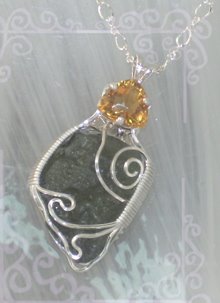
There are a few ways to create a twisted look to square wire. The old fashion way is shown here and best used for 'smaller' projects. If you are twisting a foot or two of wire, this method is good to use, but if you are twisting many many feet of wire, then an alternative would be to use a drill head or similar type tool. In this tutorial, we are using a Pin Vice and flat nose pliers.
The pin vice I'm using is two sided and each 'bit' is designed for certain gauge wires. The most common gauges for wire wrapping jewelry are 21 or 22 gauge, dead soft wire, either square or round and 'half' round banding wire. The pin vice I have will work with most wire from 24g to a larger 18 gauge wire. If you are purchasing a Pin Vice or Pin Vice set, make sure that you get the tool appropriate for the gauges you work with.
1. To create a twisted look, you are best to begin with square wire. I normally use what's called Dead Soft wire. It's easier to work with when wire sculpting or wrapping then 'hard wire' is.
Twisting the wire will create more strength in the wire also.
2. The 'tools' used are flat head pliers and a wire twisting tool called a Pin Vice. As shown in the image, the wire slips through the pin vice and is held in place by screwing the head 'closed' around the wire. Working with 2 or three inches at a time is best.
 3. Use your pliers, clamp down and hold the 'end of the wire. Holding the vice with your other hand, begin to manually turn the tool either toward you or away from you. Keep the twisting as consistent as you can. Count them per the 2 or three inches you are working with. The more you twist, the tighter the look.
3. Use your pliers, clamp down and hold the 'end of the wire. Holding the vice with your other hand, begin to manually turn the tool either toward you or away from you. Keep the twisting as consistent as you can. Count them per the 2 or three inches you are working with. The more you twist, the tighter the look.4. After you have the desired 'look' for 2 or 3 inches, stop, loosen the vice, slide it back along the square wire, exposing another 2 or 3 inches of untwisted wire. Tighten the vice and move the teeth of your flat nose pliers to hold the wire now, at the intersection of the previously twisted wire section and the section to be twisted. Begin the manual twisting process again.
5. Continue these steps until all the wire length is twisted. You will notice that the new wire has much more strength to it then the previously untwisted wire. This technique adds a great look to wire projects but is also great to use when building bails. If your project is small and you are using thin, soft wire and need to add strength to the bail, the twisting method works quite well.

Pin Vices are not that expensive and can be found at most jewelry supply shops. I think I remember purchasing mine from Wire-Sculptor.com for less then $15.00
In one of the tutorial videos I've studied in the past, I also saw a technique where twisting could be done with an electric hand drill and pliers. The same concept applies. Make sure you hold onto the loose end of the wire tightly in your pliers, using a small hand drill as the 'vice', clamp down on the end of the wire and close the bit around it. Then turn the drill 'on' or using a finger trigger, begin the drill head on 'slow'. It will start to twist your wire at a pretty decent speed.
Enjoy! I hope this helps you get started with Twisting Wire.






.JPG)
-002.JPG)












3 comments:
Love it Susan! I hope SOMEDAY I'll get the chance to try these neat things!
Jamie
Creations by JAE
http://creationsbyjae.etsy.com
http://creationsbyjae.blogspot.com
http://www.creationsbyjae.com
Very Good tutorial on wire working.Been wanting to try it.
JonWen45
http://www.jonwen45.etsy.com
http://www.jonwen45craftingcreations.blogspot.com
http://www.twitter.com/jonwen45
Very well written - thank you
Lloyd
Post a Comment